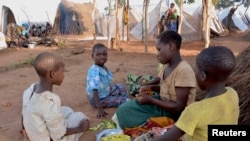The United Nations warns at least 1.5 million people in Mozambique need international assistance to see them through a disastrous El Nino-induced drought.
In the central and southern parts of Mozambique, an estimated 1.5 million people are under the strain of a drought, which has been developing for months.
The U.N. Office for the Coordination of Humanitarian Affairs reports a severe food shortage in Mozambique is taking a toll on children. OCHA spokesman Jens Laerke says some 95,000 children are acutely malnourished.
He tells VOA their condition could become life-threatening in the coming six months if they do not receive nutritional assistance.
“We are afraid that many of these children may die as a result of this. Of course, El Nino is a natural phenomenon. It happens; however, it is preventable - not the phenomenon, but that it develops into a disaster with proper response, but also preparedness. So, there may be, of course, fatalities as a direct consequence of lack of funding,” he said.
Change in rain patterns
El Nino is the warming of the western Pacific Ocean that changes normal rain patterns.
The United Nations has received only $13 million of the $203 million appeal it made for humanitarian operations in Mozambique this year.
Laerke says 423,000 people received food assistance in April and May. Because of the funding shortage, he says 100,000 fewer people will receive food in June.
He says farmers in rural communities are in particular trouble and that nearly one-half-million farmers who grow rain-fed crops have lost their harvest because of the drought. In Mozambique's southern region, he says almost all planted crops for the main growing season also have been lost to drought.
The U.N.’s assistance program focuses on providing food, nutrition, water and sanitation services and early recovery to get people back on their feet once the drought is over.








